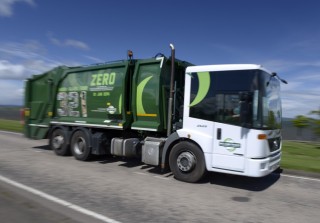3, 2, 1, ZERO
William Tracey Group: Helping customers meet the Waste (Scotland) Regulations
 New regulations to help Scotland become one of the most resource efficient nations in Europe have been passed by the Scottish Parliament on 9 May 2012.
New regulations to help Scotland become one of the most resource efficient nations in Europe have been passed by the Scottish Parliament on 9 May 2012.
The regulations aim to support efforts to meet Scotland’s ambitious recycling targets of 70% recycling by 2025.
A phased approach to rolling out the key measures in the regulations has been adopted to ensure that there is sufficient time for businesses, particularly small businesses, to adopt new recycling services.
With less than a year until the regs come into force, we are now in the countdown phase meaning you should start to take action now in order to be compliant when the regs come into force in January 2014.
For more information see our Waste (Scotland) Regulations Toolbox Talk.
How can we help?
William Tracey Group are the first business in Scotland to invest in split bodied vehicles. Our collection vehicles are split into 3 segregated compartments making your countdown to the Waste (Scotland) Reg as easy as 3, 2, 1!
3 – MIXED RECYCLING
2 – GLASS
1 – FOOD
ZERO – leaving you with very little waste , if any, for landfill.
One vehicle for collection of these three recycling bins …
- Reduces carbon footprint
- Saves you money by reducing your uplifts
- Means you are segregating waste in line with the Waste (Scotland) regulations
3 – MIXED RECYCLING
The new legislation requires businesses to present metal, plastic, glass, paper and card for separate collection from 1 January 2014.
All items except glass can be collected as ‘Mixed Recycling’ in one bin and will be treated at one of our sophisticated Materials Recycling Facilities (MRF’s) where the materials will be segregated into separate waste streams.
Following the waste hierarchy, materials will become valuable commodities, going on to be recycled into other products as an alternative to using raw materials.
Some examples of Mixed Recycling:
- Paper
- Printing
- Envelopes
- Newspapers
- Catalogues
- Cardboard
- Plastic wrappers
- Drinks Cans
- Food cans
- Empty milk bottles
- Empty drinks bottles
- Plastic bags
- Plastic food packaging
- Empty vending cups
Reducing your Mixed Recycling:
- Reduce packaging of the products you buy
- Encourage employees to bring their own cups to work instead of using vending cups
- Switch to a paperless office
- Cancel magazine and newspaper subscriptions and opt for online versions
2 – GLASS
Glass must be collected separately from Mixed Recycling streams as there is no current technology available for separating it from other materials. Landfilling glass is not sustainable. It does not degrade and so once in a landfill, will be there forever. If recycled, glass can be used to create another glass product over and over again. Recycling glass reduces the amount of resources needed to produce new glass and uses a lot less energy.
Once collected, the glass will be taken to our depots. Clear glass is used to manufacture tiny spherical beads which are used in shot blasting or added to paint to add a reflective quality to paint used for road markings.
Mixed glass is treated in our aggregates division to make a range of glass aggregate products used commonly in construction and utilities industries for pipe bedding.
1 – FOOD
Stage 1: Food businesses (except in rural areas) which produce over 50 kg of food waste per week to present that food waste for separate collection from 1 January 2014.
Stage 2: Food businesses (except in rural areas) which produce over 5 kg of food waste per week to present that food waste for separate collection from 1 January 2016.
The recycling of food waste applies to food which is produced on your premises. For example, packed lunches and food brought in by employees of the business is not included in the legislation but food waste generated from canteen’s and prepared or manufactured on your premises is.
Whether you fall in to the stage 1 or 2 category, you should start to consider recycling food waste. We are equipped to help you to implement a food recycling into your business.
We turn food waste into renewable energy! Your food waste will go on to power homes and businesses through the process of Anaerobic Digestion. Food is treated with micro bugs which generate a methane gas which is captured and sold onto the National Grid. The process also generates a bi product of organic slurry which can be used as fertilised in agriculture.
- Leftovers and uneaten scraps
- Peelings, cuttings and trimmings
- Unsold packaged food
- Out of date or spoiled materials
- Processing residues
- Fats, oils and greases
Reducing you Food Waste
- Store and package food correctly
- Reduce portion sizes
- Offer special deals on foods nearing sell by dates
A QUICK SUMMARY
The Waste (Scotland) Regulations 2012 were passed by the Scottish Parliament on 9 May 2012. The regulations make the following provisions.
- Businesses to present metal, plastic, glass, paper and card for separate collection from 1 January 2014.
- Food businesses (except in rural areas) which produce over 50 kg of food waste per week to present that food waste for separate collection from 1 January 2014.
- Food businesses (except in rural areas) which produce over 5 kg of food waste per week to present that food waste for separate collection from 1 January 2016.
- Local authorities to provide a minimum recycling service to householders.
- Waste contractors to provide collection and treatment services which deliver high quality recycling.
- A ban on any metal, plastic, glass, paper, card and food collected separately for recycling from going to incineration or landfill from 1 January 2014.
- All new incinerators must ensure that metals and dense plastics have been removed from residual municipal waste prior to incineration.
- A ban on biodegradable municipal waste going to landfill from 1 January 2021.
We have the experience, infrastructure and a range of packages tailored to your needs. Call us today and make sure you are 3,2,1 ZERO ready to launch on the journey to zero waste…!



